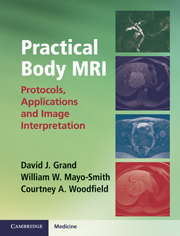Book contents
- Frontmatter
- Contents
- Preface
- To the reader
- Acknowledgments
- Glossary of terms andabbreviations used in Body MRI
- Section 1 Body MRI overview
- Section 2 Abdomen
- Chapter 2 Liver
- Chapter 3 Pancreas and biliary tree
- Chapter 4 Kidneys
- Chapter 5 Adrenal glands
- Chapter 6 MRI enterography
- Section 3 Pelvis
- Section 4 MRI angiography
- Index
- References
Chapter 3 - Pancreas and biliary tree
from Section 2 - Abdomen
Published online by Cambridge University Press: 05 November 2012
- Frontmatter
- Contents
- Preface
- To the reader
- Acknowledgments
- Glossary of terms andabbreviations used in Body MRI
- Section 1 Body MRI overview
- Section 2 Abdomen
- Chapter 2 Liver
- Chapter 3 Pancreas and biliary tree
- Chapter 4 Kidneys
- Chapter 5 Adrenal glands
- Chapter 6 MRI enterography
- Section 3 Pelvis
- Section 4 MRI angiography
- Index
- References
Summary
MRI cholangiopancreatography (MRCP)/pancreas protocol
Indications
This protocol is used for evaluation of the biliary tree and pancreas. Indications include biliary ductal dilatation, suspicion of choledocholithiasis, jaundice, pancreatitis, pancreatic mass.
Preparation
IV contrast agent: 1 mmol/kg gadopentetate dimeglumine at 2 cc/s
Oral contrast agent: Mixture 3 oz. ferumoxsil and 3 oz. barium sulfate 30 minutes prior to study. If 30 minutes is not available, have patient lie on right side for 5 minutes prior to study
2 L nasal oxygen
At least 24-gauge IV; connect to power injector
Cover from dome thru entire liver
Find the best visualization of the ducts and repeat coronal single-shot fast-spin echo slab 30 mm thick 10 times.
Exam sequences
(1) Diffusion-weighted imaging b50, 500/ADC – Very sensitive sequence for lesion detection.
(2) Axial thin slice single-shot fast-spin echo FS BH – Evaluate for choledocholithiasis.
(3) Coronal thin slice single-shot fast-spin echo FS BH – Confirm biliary duct stones, evaluate for ductal stricture.
(4) Coronal single-shot fast-spin echo thick slab (30 mm) – Repeat 10 x – Assess distal CBD (ampulla), nice overall image of biliary tree. Repeated images to assure at least one with open sphincter of Oddi.
(5–6) Axial T1 in- and out-of-phase (IP/OOP) – Identify focal fat in the pancreas, don’tmistake it for a mass.
(7) Axial T1-weighted volume-interpolated gradient echo pre-contrast BH – Identify masses/material which are T1-bright before contrast administration. The fat saturation of this sequence increases relative signal in the pancreas and is good for identifying more subtle pancreatic masses.
(8) Axial T1-weighted volume-interpolated gradient echo BH post IV administration of contrast at 20 seconds. Look for hypervascular lesions such as islet cell tumours.
(9) Axial T1-weighted volume-interpolated gradient echo BH post IV administration of contrast at 1 minute.
(10) Axial T1-weighted volume-interpolated gradient echo BH post IV administration of contrast at 2 minutes.
(11) Axial T1-weighted volume-interpolated gradient echo BH post IV administration of contrast at 3 minutes.
- Type
- Chapter
- Information
- Practical Body MRIProtocols, Applications and Image Interpretation, pp. 36 - 48Publisher: Cambridge University PressPrint publication year: 2012



